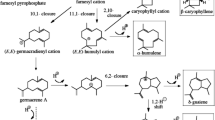Abstract
The resinous portions of Aquilaria plants, called agarwood, have been used as medicines and incenses. Agarwood contains a great variety of sesquiterpenes, and a study using cultured cells of Aquilaria crassna showed that the production of sesquiterpenes (α-guaiene, α-humulene, and δ-guaiene) was induced by treatment with methyl jasmonate, which led to the cloning of δ-guaiene synthases. In the present study, analyses of genomic organization and Southern blotting of δ-guaiene synthase in A. crassna were performed in order to examine the genomic background of δ-guaiene synthases in Aquilaria plants. Genomic cloning and sequencing revealed five types of sequence in putative δ-guaiene synthases sharing more than 96% identity in exon regions, and that these enzymes belonged to the class III TPS subfamily with seven exons and six introns. Furthermore, Southern blotting revealed that at least five copies of δ-guaiene synthase existed in A. crassna. The hybridization of digested DNA of A. crassna and A. sinensis with probes made with a δ-guaiene synthase cDNA fragment resulted in different banding patterns for these two species. It may be possible to identify Aquilaria species by restriction fragment length polymorphism analyses with δ-guaiene synthase cDNA probes.




Similar content being viewed by others
Notes
Supplement I to the Japanese Pharmacopoeia, fifteenth edition, general information 31: purity tests on crude drugs using genetic information.
References
Varma KR, Maheshwari ML, Bhattacharyya SC (1963) The constitution of agarospirol, a sesquiterpenoid with a new skeleton. Tetrahedron 21:1079–1090
Nakanishi T, Yamagata E, Yoneda K, Miura I (1981) Jinkohol, a prezizane sesquiterpene alcohol from agarwood. Phytochemistry 20:1597–1599
Hashimoto K, Nakahara S, Inoue T, Sumida Y, Takahashi M, Masada Y (1985) A new chromone from agarwood and pyrolysis products of chromone derivatives. Chem Pharm Bull 33:5088–5091
Ishihara M, Tsuneya T, Uneyama K (1993) Fragrant sesquiterpenes from agarwood. Phytochemistry 33:1147–1155
Yagura T, Ito M, Kiuchi F, Honda G, Shimada Y (2003) Four new 2-(2-phenylethyl) chromone derivatives from withered wood of Aquilaria sinensis. Chem Pharm Bull 51:560–564
Anonymous (2005) The official gazette 4010:3
Ito M, Honda G (2005) Taxonomical identification of agarwood-producing species. Nat Med 59:104–112
Ito M, Okimoto K, Yagura T, Honda G (2005) Induction of sesquiterpenoid production by methyl jasmonate in Aquilaria sinensis cell suspension culture. J Essent Oil Res 17:175–180
Okudera Y, Ito M (2009) Production of agarwood fragrant constituents in Aquilaria calli and cell suspension cultures. Plant Biotech 26:307–315
Kumeta Y, Ito M (2010) Characterization of δ-guaiene synthases from cultured cells of Aquilaria, responsible for the formation of the sesquiterpenes in agarwood. Plant Physiol 154:1998–2007
Thompson JD, Higgins DG, Gibson TJ (1994) CLUSTAL W: improving the sensitivity of progressive multiple sequence alignment through sequence weighting, position-specific gap penalties and weight matrix choice. Nucleic Acid Res 22:4673–4680
Saitou N, Nei M (1987) The neighbor-joining method: a new method for constructing phylogenetic trees. Mol Biol Evol 4:406–425
Trapp SC, Croteau RB (2001) Genomic organization of plant terpene synthases and molecular evolutionary implications. Genetics 158:811–832
Brown JWS, Simpson CG (1998) Splice site selection in plant pre-mRNA splicing. Annu Rev Plant Mol Biol 49:77–95
Bohlmann J, Steel CL, Croteau R (1997) Monoterpene synthases from Grand Fir (Abies grandis): cDNA isolation, characterization, and functional expression of myrcene synthase, (−)-(4S)-limonene synthase, and (−)-(1S, 5S) pinene synthase. J Biol Chem 272:21784–21792
Dudareva N, Martin D, Kish CM, Kolosova N, Gorenstein N, Fäldt J, Miller B, Bohlmann J (2003) (E)-β-ocimene and myrcene synthase genes of floral scent biosynthesis in Snapdragon: function and expression of three terpene synthase genes of a new terpene synthase subfamily. Plant Cell 15:1227–1241
Lücker J, Bowen P, Bohlmann J (2004) Vitis vinifera terpenoid cyclases: functional identification of two sesquiterpene synthase cDNAs encoding (+)-valencene synthase and (−)-germacrene D synthase and expression of mono- and sesquiterpene synthases in grapevine flowers and berries. Phytochemistry 65:2649–2659
Bohlmann J, Meyer-Gauen G, Croteau R (1998) Plant terpenoid synthases: molecular biology and phylogenetic analysis. Proc Natl Acad Sci USA 95:4126–4133
Eurlings MCM, Gavendeel B (2005) TrnL-trnF sequence data imply paraphyly of Aquilaria and Gyrinops (Thymelaeaceae) and provide new perspectives for agarwood identification. Plant Syst Evol 254:1–12
Eurlings MCM, Beek HH, Gravendeel B (2010) Polymorphic microsatellites for forensic identification of agarwood (Aquilaria crassna). Forensic Sci Int 197:30–34
Acknowledgments
This work was supported by the Takeda Science foundation (funds to M. I.).
Author information
Authors and Affiliations
Corresponding author
Rights and permissions
About this article
Cite this article
Kumeta, Y., Ito, M. Genomic organization of δ-guaiene synthase genes in Aquilaria crassna and its possible use for the identification of Aquilaria species. J Nat Med 65, 508–513 (2011). https://doi.org/10.1007/s11418-011-0529-7
Received:
Accepted:
Published:
Issue Date:
DOI: https://doi.org/10.1007/s11418-011-0529-7




